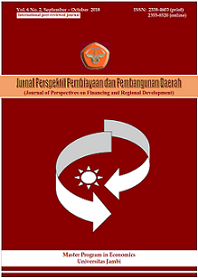Dynamic links between economic growth, institutions, fiscal policy and stock market development
DOI:
https://doi.org/10.22437/ppd.v6i2.5391Abstract
Economic growth is a most crucial factor that plays its role to improve the living standards in a country. But there is no consensus about the variables explaining the economic growth of economies. This paper is an attempt to explore the impact of institutional quality, instruments of fiscal policy, and stock market development on economic growth for a small developing economy, Pakistan over the time span of 1984-2016. To determine the long and short run relationship of the variables, Auto Regressive Distributed Lag (ARDL) bounds testing approach to integration is applied. An index of institutional quality is constructed by Principal Component Analysis (PCA) considering twelve institutional indicators given by International Country Risk Guide (ICRG). The findings of the study reveal a positive relationship of public spending, institutional quality and stock market development on economic growth of the country. It is suggested that improvement of institutional quality, productive public spending and efficient financial markets are driving forces for economic prosperity and development of Pakistan.
Downloads
References
Alesina, A. (1998). The Political Economy of High and Low Growth, in Annual World Bank Conference on Development Economics, Washington DC: World Bank.
Atje, R., Jovanovic, B. (1993). Stock Markets and Development. European Economic Review, 37, 632-640.
Barro, R. J. (1990). Government Spending in a Simple Model of Endogenous Growth. Journal of Political Economy, 98(5): 103-125.
Barro, R. J. and Sala-i-Martin, X. (1992). Public Finance in Models of Economic Growth. Review of Economic Studies, 59: 645-661.
Benos, N. (2009). Fiscal Policy and Economic growth: Empirical Evidence from EU Countries. Working Paper, University of Loannina, Greece.
Bleaney, M. F., Gemmel, N., Kneller, R. (2001). Testing the Endogenous Growth Model: Public Expenditure, Taxation, and Growth over the Long Run. Canadian Journal of Economics 34(1): 36-57.
Boubakari, A., Jin, D. (2010). The Role of Stock Market Development in Economic Growth: Evidence from some Euro next countries. International Journal of Financial Research, 1(1), 14-20.
Christie, A. L. (2011). Essays on Fiscal Policy and Economic Growth. Ph.D. Dissertation, Georgia State University, Economics Department.
Cojocaru, L., Hoffman, S.D., Miller, J.B. (2014). Financial System Development and Economic Growth in Transition Economies: New Empirical Evidence from the CEE and CIS countries. Working Paper Series, University of Delaware. Available from: https://www.sites. udel.edu/saul-hoffman/files/2014/03/FinancialDevelopmentGrowth- FINAL-1vugriz.pdf.
Enisan, A.A., Olufisayo, A.O. (2009). Stock Market Development and Economic Growth: Evidence from Seven Sub-Sahara African Countries. Journal of Economics and Business, 61, 162-171.
Feng, Y. (2003). Democracy, Governance and Economic Performance: Theory and Evidence. Cambridge: MA, MIT Press.
Glaeser, (2004). Do Institutions Cause Growth? Journal of Economic Growth, 9(3): 271-303.
Goldsmith, R.W. (1969). Financial Structure and Development. New Haven, CT: Yale University Press.
Hall, R. E., Jones, C. (1999). Why Do Some Countries Produce So Much More Output Per Worker Than Others? Quarterly Journal of Economics, 114: 83-116.
Hassan, M. T. (2002). Governance and Poverty in Pakistan. MIMAP Technical Series, No.13. Pakistan Institute of Development Economics, Islamabad.
Hondroyiannis, G., Lolos, S., Papapetrou, E. (2005). Financial Markets and Economic Growth in Greece, 1986–1999. International Financial Markets, Institutions and Money, 15, 173-188.
Ibrahim, O. A., Gadir, S. E. M. (2015). Motives and Determinants of FDI: A VECM Analysis for Oman. Global Business Review, 16(6): 936-946.
Kakar, Z. K. (2011). Impact of Fiscal Variables on Economic Development of Pakistan. Romanian Journal of Fiscal Policy, 2(2):1-10.
Knack, S., Keefer, P. (1995). Institutions and Economic Performance: Cross-Country Tests Using Alternative Institutional Measures. Economics and Politics, 7(3): 207-227.
Kneller, R., Bleaney, M. F., Gemmel, N. (1999). Fiscal Policy and Growth: Evidence from OECD Countries. Journal of Public Economics, 74: 171-190.
Levine, R. (1997). Financial Development and Economic Growth: Views and Agenda. Journal of Economic Literature, XXXV, 688-726.
Levine, R., Zervos, S. (1998). Stock Markets, Banks and Economic Growth. American Economic Review, 88, 537-557.
Madni G. R. (2013), Instrumental Effects of Fiscal Policy for Pakistan Economy. The Romanian Economic Journal, 50: 27-49.
Madni, G. R. (2014). Taxation, Fiscal Deficit and Inflation in Pakistan. The Romanian Economic Journal, 53: 41-60.
Downloads
Published
How to Cite
Issue
Section
License
Copyright (c) 2018 Ghulam Rasool Madni

This work is licensed under a Creative Commons Attribution 4.0 International License.

















